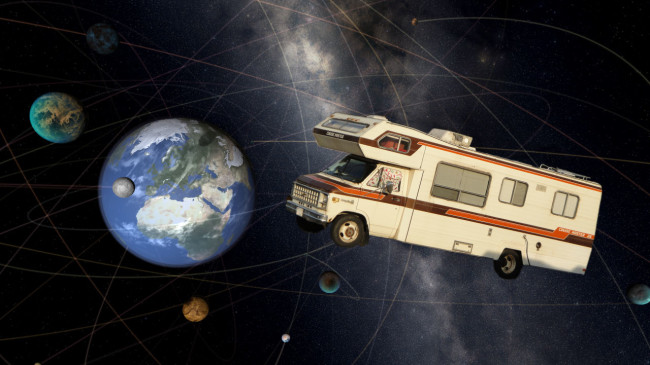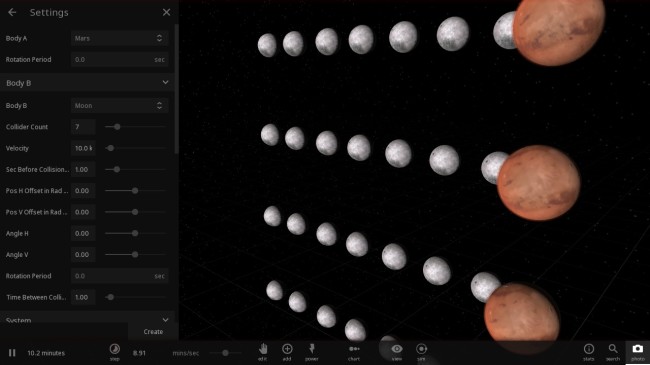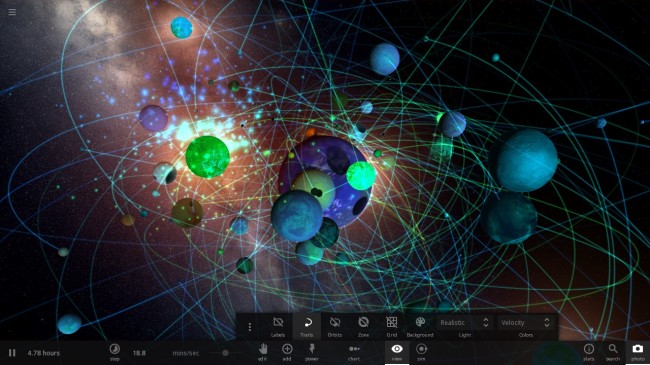Development
VR is Now Available for Universe Sandbox ²
Apr 4th
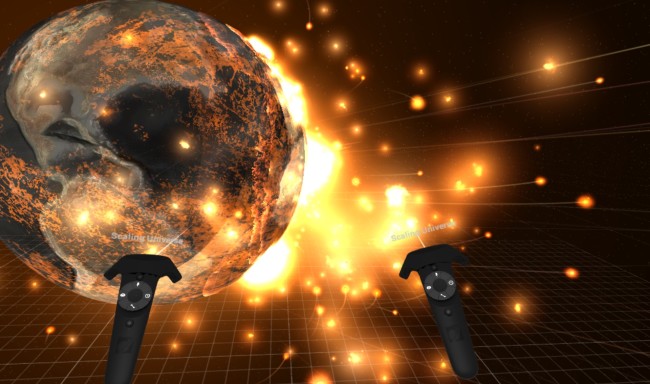
For the past few months our highest priority has been adding in HTC Vive/SteamVR support for Universe Sandbox ². The team’s hard work has paid off: we now have a fully-functional virtual reality version which allows you to walk and fly around your simulations, melt planets with a giant laser, then grab them and hurl them off into nothingness with a flick of the wrist.
The best way to experience the amazing sense of scale and immersion in Universe Sandbox ² VR is to put on a headset and check it out for yourself. But if that’s not possible, then here’s a trailer for Universe Sandbox ² VR, featuring user-created VR gameplay videos courtesy of Brad Lynch and Count Lorek of BMcD Gaming.
VR is Free for Owners of Universe Sandbox ²
Universe Sandbox ² now includes both the desktop version and the new VR mode. So anyone who buys Universe Sandbox ² will also receive Universe Sandbox ² VR, and anyone who already owns Universe Sandbox ² can access the VR mode at no extra charge.
If you own Universe Sandbox ² on Steam and have access to a Vive, just run Steam to update. Then launch Universe Sandbox ² and select “Launch Universe Sandbox ² in Steam VR Mode” in the popup dialog box.
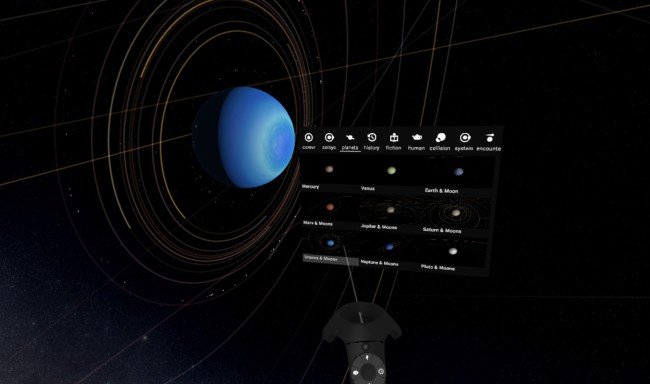
Lots of Love for Universe Sandbox ² VR at GDC
Thanks to Valve, we were able to demo our VR version of Universe Sandbox ² in the Steam booth two weeks ago at GDC, the world’s largest professionals-only video game conference.
We received great feedback from everyone who stopped by for a demo, with many agreeing that it was one of the most compelling VR experiences they had tried.
PC Gamer assistant editor Tom Marks said Universe Sandbox ² “was one of the coolest thing [he’s] tried on Vive so far.” Check out the video below for his discussion of Universe Sandbox ² VR:
Scott Manley, a popular YouTuber whose videos combine science and games, was one of the first to stop by for a demo:
Casually throwing Mars through Saturn's rings in @UniverseSandbox pic.twitter.com/6GX3ZYTd0H
— Scott Manley (@DJSnM) March 17, 2016
Here’s a small write-up from Rock Paper Shotgun editor Graham Smith: Universe Sandbox ² Now Has a Virtual Reality Mode
In another article about VR, Graham mentions Universe Sandbox ² as one of the few upcoming VR games which he thinks “look spectacular.”
And here’s an older article from UploadVR, based on an interview with Dan, creator and project lead on Universe Sandbox ²: Literally Play Pool with the Planets in Universe Sandbox ² VR
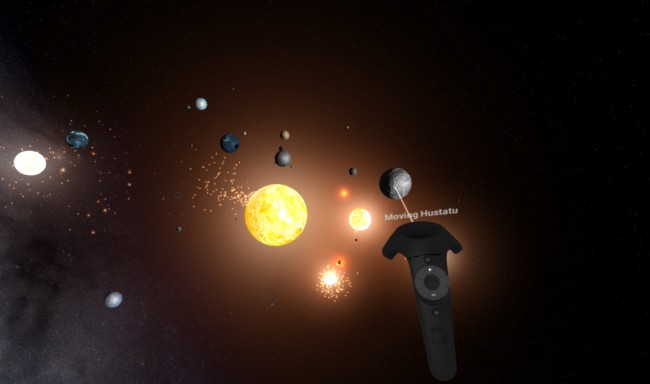
What’s Next for VR?
We still have work to do, but we’ve already got an enjoyable and impressive VR experience. Beyond adding polish to the interface, we also have to work on getting the best performance possible in order to keep up with VR requirements of 90 frames per second. With VR it’s crucial to meet this requirement in order to keep the risk of motion sickness at a minimum.
We’ll continue to work on the VR version as well as the desktop version, and we’ll release updates when they’re ready. We don’t support Oculus Rift yet, but we’re looking into adding this in once the Touch is available.
You can buy Universe Sandbox ² on our website or on the Steam Store.
Did We Say VR? We Meant RV! Cruise Around Space with RV Mode
Apr 1st
RV photo credit: Greg Gjerdingen (CC License)
RV Mode is Coming Soon to Universe Sandbox ² (sorry, it’s RV, not VR mode)
First, we must apologize for this typo which was made many, many times in many of the posts here and on our promotional material. While we’re not sure who was responsible for editing these posts, we’re in the process of hiring someone now who can find the culprit and immediately fire them. We will then immediately fire this new employee as well.
So to be clear, we meant to say RV mode, not VR mode. We’re talking recreational vehicles here, not virtual reality. Yep, RVs, those huge clunky things you can use to take the whole family on the greatest ever cross-country road trip, with no need for rest stops because inside of that RV you’ve got a bathroom, plenty of room to pace back and forth, and, if you’re lucky, even a satellite TV.
Step Inside the RV of Your Dreams… In Space
While a VR mode for Universe Sandbox ² does sound pretty cool (we’ll look into this), the RV mode which we’ve actually been focusing on for the past few months is something which we think you’ll agree is way cooler.
Just imagine: You load up a simulation of our solar system and engage RV Mode. Suddenly you’re sitting in the cushy front seat of your very own recreational vehicle, feeling like royalty on the Intergalactic Highway. You kick it into high gear and blaze through space at 60 miles per hour (that’s about 96 km/h if you’re in Europe), looking out the huge, panoramic windshield as you pass the gas giants of our solar system. What’s that, not interested in Jupiter’s moons? No problem, take a break and check out the kitchenette. Explore the mini-fridge. Explore the contents of the pot on the hot-plate. Are you picking up a signal on the satellite TV? If so, explore the 200+ channels of premium content.
Of course, while making this RV Mode we haven’t forgotten about the spirit of the sandbox. So yes you can still experiment and get answers to fantastical what-if questions like, “What if I put the hot tub jets [yes you can unlock a hot tub] on full blast? How much sooner will I run out of gas?” or “What if I open the windows?” or “What if I drive this thing right into the sun?”
Why RV Mode for Universe Sandbox ²?
Good question. But have you considered “Why not?”
Truth be told, this may seem like it’s coming out of left field for a space and gravity simulator, but since day one it’s been part of the dream for Universe Sandbox ². Dan Dixon, creator and project lead on Universe Sandbox ², pointed out the obvious reason: “The driving force behind this project has always been about giving the player the freedom and tools to do whatever they want. And what embodies freedom more than cruising around the universe in an RV?”
So forget about exploring your Universe Sandbox ² simulations in full 3D and waving your hands around to make planets collide. The real frontier of next-generation gaming lies in the powerful and inspiring potential of the RV, the cutting edge of unwieldy, carbon-friendly (and family-friendly) automobiles.
Again, sorry for all those typos.
Exploring Some Lesser-Known Features
Mar 7th
Maybe you’ve noticed that there are a lot of features in Universe Sandbox ². As we continue development, we work on ways to make all of these features discoverable and easy-to-use.
But some remain a little hidden right now. So here’s a list of some of the features we see commonly requested, and which are actually already in Universe Sandbox ².
1. You can fly the camera around your simulation using the WASD keys.
- Use the WASD keys on your keyboard to freely move the camera around
- Click and drag the mouse to point the camera in a different direction
- You can use this to focus the camera on a point in your simulation instead of a specific body
2. Want to see moons and rings in our solar system? The default sim doesn’t have these because they tend to slow things down, but you can load sims which do.
- Search for “moon” or “ring” in Home > Open to find simulations which have the moons and rings of our solar system
- These sims require a lot of accuracy to keep moons and rings in tight orbits, so they tend to run slower than a standard simulation
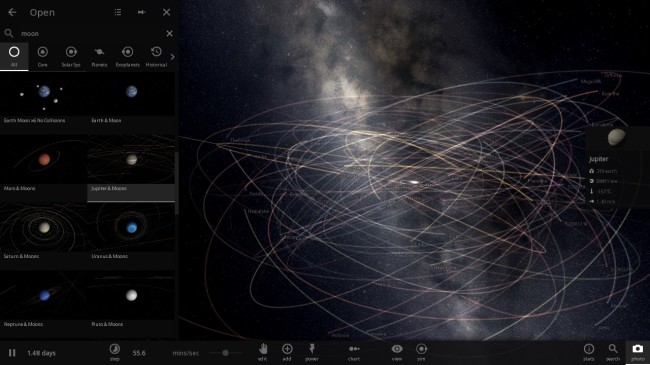
3. Or you can add rings yourself to any body in a simulation.
- Select a Body > Add > Rings tab > Select a preset > Add Ring
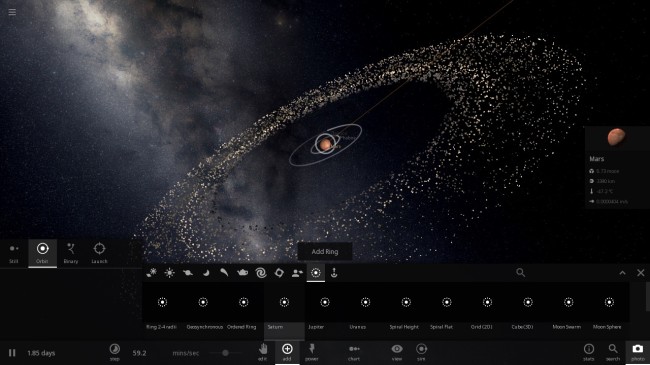
4. Universe Sandbox ² has a database of over 50 thousand known objects.
- Use the search bar in the Add panel to find less common objects
- Add > Search bar (top right)
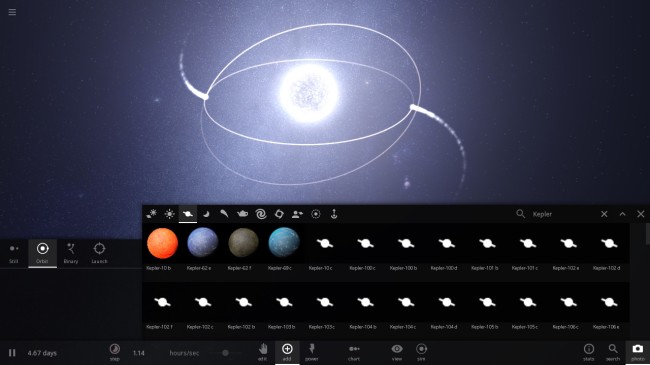
5. You can land the camera on the surface of a body.
- Click twice to focus on a body > Press C on your keyboard
- Press C again to return to the normal camera view
- Getting dizzy? Properties > Motion tab > Rotation Lock (bottom of list)
6. You can create randomly-generated solar systems.
- Home > Create > Systems
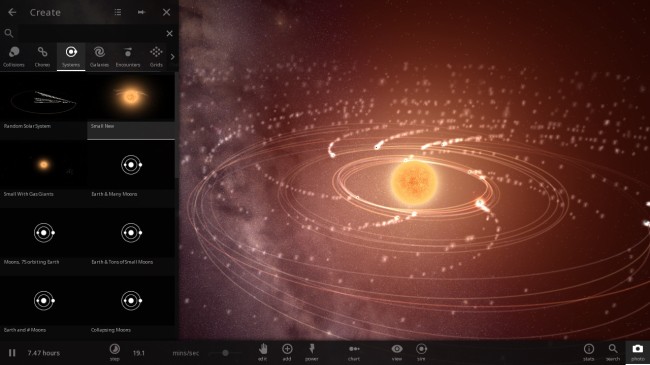
7. Earth and Mars both have climate simulation.
- Select Earth or Mars > Properties > Climate tab > Enable Climate
- Learn more about how we simulate climate in our Climate post
8. Accidentally delete the sun? No worries, you can Undo!
- Press Ctrl+Z on your keyboard to undo your last action
- This is still a work-in-progress feature and does not undo every action
9. You can change the frame of reference for trails.
- Select a body > Properties > Actions tab > Set as Trail Center
- Return to default: Actions tab > Clear Trail Center
- For example, instead of seeing how bodies in our solar system move in relation to the sun, you can see how they move in relation to Earth, as shown in the screenshot below
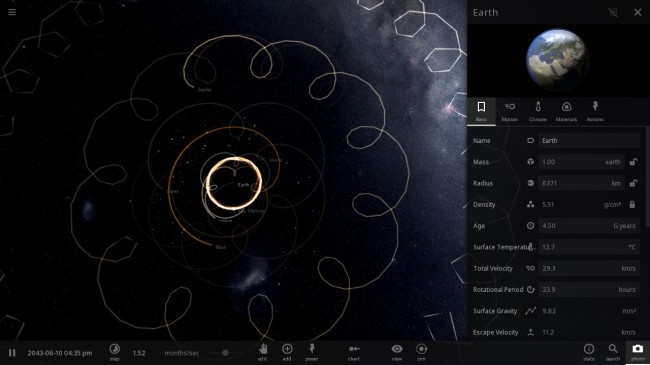
10. You can view and customize keyboard shortcuts for many commands.
- Home > Settings > Input
11. You can hide the interface at any time for a more cinematic view.
- Press Tab on your keyboard to hide the interface
- Press Tab again to make it return
12. You can change a simulation’s starting date, have it start paused, and adjust other advanced starting parameters.
- Home > [Open or Create] > Hover over a preset and click the pencil icon
13. Bodies and trails can be colored according to their velocity, mass, or acceleration.
- View > Colors
Working Through the N-Body Problem in Universe Sandbox ²
Feb 26th
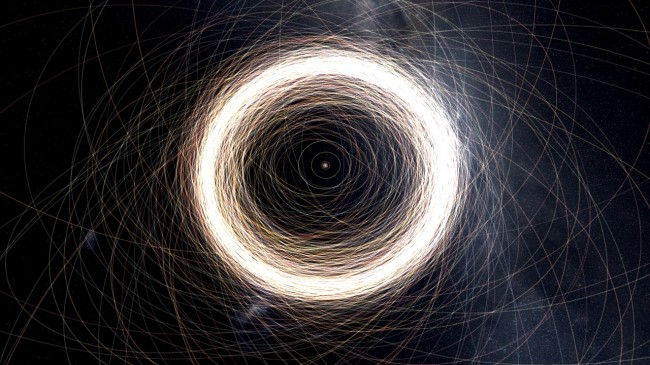
Orbits of major planets and all possible dwarf planets in our solar system. (From Universe Sandbox ²)
What is the n-body problem?
The n-body problem can be defined as “the problem of predicting the individual motions of a group of celestial objects interacting with each other gravitationally.” Or, in a gravitational system of n bodies (where n can be any number), where will they all be after one year?
It’s helpful to frame this in contrast to the two-body problem, which looks at the motion of just two objects interacting with each other. For example, you can look at the Earth and Moon as a two-body problem. The Earth pulls on the Moon quite a bit, keeping it in orbit, and the Moon pulls on the Earth just a little bit.
The issue here is that the Moon is not affected gravitationally by just the Earth; it is also being pulled by the Sun, and Jupiter, and every other object in space. The same is true when looking at the Sun and Earth: the Sun is not the only object pulling on Earth. So to account for all of these gravitational forces, you need to use an n-body solution.
The problem of the n-body problem in Universe Sandbox ²
In Universe Sandbox ², every object is simulated as part of an n-body problem. Unfortunately, when solving for many objects, or n objects, you can’t just jump forward in time without getting massive errors. There’s simply no way around this. Solving an n-body problem requires calculating how each object affects each other object every step of the way. Errors will still happen, but taking smaller steps reduces them.
By default, the simulations in Universe Sandbox ² try to set an accuracy which prevents orbits from falling apart due to error. This means setting a maximum error tolerance for each step and also making sure the total error doesn’t reach an upper limit.
If you crank up the time step, the simulation then has to take fewer, larger steps. This means the potential for greater error. And the greater the error, the more likely it is that an orbit, which otherwise would be stable, falls apart. Moons crash into planets, Mercury gets thrown out of the solar system — things like that.
This isn’t what most people want in their simulations. But at the same time, most people also don’t want a limit on how fast they can run their simulation. This is a problem.
An imperfect solution
So how can we get around this problem? How can we accurately simulate thousands of objects while still allowing for large steps forward in time? For example, what if you wanted to simulate our solar system on a time scale of millions of years per second so that you could see the evolution of our Sun?
One solution proposed by Thomas, our physics programmer, is to allow for a special mode within simulations running at high time steps. This mode (which of course could be toggled) would collapse the existing n-body simulation into a series of 2-body problems: Moon & Earth, Earth & Sun, Europa & Jupiter, Jupiter & Sun, etc.
Solving a 2-body problem is much easier than solving an n-body problem. Not only is it faster computationally, but there is also a relatively arbitrary difference between figuring out where the two objects will be in one year and where they’ll be in a million years — it still requires just one calculation. So if you collapse an n-body simulation into a series of two-body problems, the simulation could take one big step forward, instead of taking the small steps needed for calculating it as an n-body problem.
The results won’t be entirely accurate, as this method would effectively ignore all gravitational influences outside of the main attractor. As mentioned before, calculating Earth’s orbit by looking at how it interacts with just the Sun is not accurate, as Earth is also affected by every other body. The Sun, however, is the most significant factor by far, because it is much more massive than any other object in our solar system. The other, much smaller forces tend to have little effect overall in non-chaotic systems. So while it’s not correct, it’s close enough when simulating something relatively stable like our solar system.
This isn’t a perfect solution. But we think it could be an improvement over the current system and its limitations, which leave you with the choice of either destabilizing the orbits with massive errors, or waiting days for the simulation to advance the millions of years needed for the Sun to evolve. Neither is particularly interesting.
When is this coming to Universe Sandbox ²?
Not anytime soon.
This solution is just a proposed idea right now, and is not a high priority for us, as we already have a big list of exciting features planned. But we think it is useful to understand the complexity of accurately simulating the motions of hundreds to thousands of objects interacting gravitationally.
This is especially a challenge when attempting to do this in real-time on a home computer, which is why researchers run numerical simulations on supercomputers which take days to complete. With Universe Sandbox ², we’re exploring new territory and working through problems which haven’t been solved before. And this is a big part of why we love making it.
Gravitational Waves & Universe Sandbox ²
Feb 15th
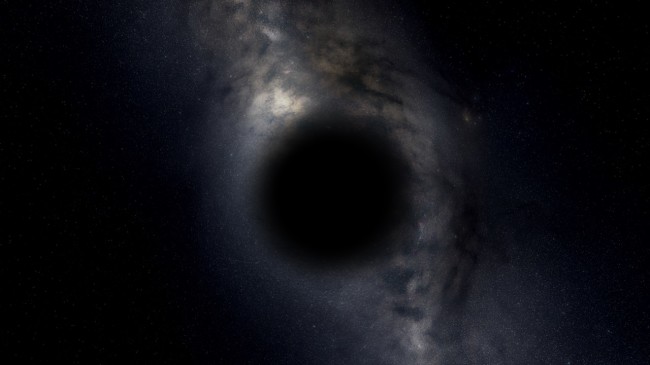
A black hole in Universe Sandbox ². Researchers concluded the detected gravitational waves resulted from two black holes colliding.
What’s the significance of discovering gravitational waves?
This announcement is a huge deal. It is on par with the discovery of the Higgs Boson particle which provided the missing evidence for a prediction of the Standard Model of particle physics. Gravitational waves are a century-old (almost exactly) prediction now confirmed by a huge number of relentless, and brilliant people after many years of hard work. It is the first direct confirmation of the prediction from Einstein’s General Relativity that matter and energy determine the motion of bodies by warping the fabric of spacetime itself, and in so doing, emanate ripples when massive bodies are accelerated through that space.
It is not only confirmation of general relativity, though. It is also the first of many future observations that will look at the universe in a completely new way. Up until now we’ve used only photons (telescopes all along the electromagnetic spectrum) and sometimes neutrinos. Now we can add listening to the fabric of space to our list of tools. This will allow us to see the dark and the obscured parts of the universe: the early universe, centers of galaxies, things blocked by dust clouds, and so on, by listening for changes in space itself. It is the start of a new age in astronomy.
In addition to this detection being the first direct proof that the predictions of general relativity that matter and energy warp space time are true, and some of the strongest evidence for the reality of black holes, this is also a new kind of astronomy. Though gravity is the weakest force and gravitational waves are very hard to detect, they do have a few advantages over observations of photons.
- First, gravitational waves are practically impervious to matter in their path. This means we can see into regions of space that are blocked to optical observatories, such as inside dense clouds of dust, the centers of galaxies, behind large or close bodies.
- Second, this is an observation of the warping of space itself, meaning we can detect things that have mass but might not produce observable light, such as black holes, dense sources of dark matter (if such were to exist), cosmic string breaks, etc.
- Third, gravitational waves fall off in amplitude much more slowly than light. This means that we can receive signals from very far away that we might not notice optically.
- And fourth, because gravitational waves also travel at the speed of light and don’t have to bounce off intervening matter, and begin to be potentially detectable from bodies getting close rather than just after the moment of collision, this means that we can work with other telescopes and tell them “Look over there! You’re probably going to see something exciting!”
This all of means that this detection means the beginning of a new kind of observational astronomy, as well as a better understanding of of of the fundamental forces of the universe, gravity.
What role did Jenn, astrophysicist and Universe Sandbox ² developer, play in the discovery?
While I was in the field I ran super-computer simulations to make predictions about the gravitational wave signals that would be produced by binary black hole mergers. Those waveforms are used as templates in the detector pipeline. The detector matches the template banks against the incoming data to find real signals amidst the noise of the detector, while also doing searches for large burst signals (how this one was found). Those waveforms are then used again to determine where the signal came from, what it was (two black holes, a neutron star and a black hole, two neutron stars, etc), and the properties of the bodies that created the signal (spins, masses, separation, etc.). I also worked on developing the analytical formulas to determine those spins and masses from those signals.
Here’s one of the scientific papers on the process of determining the properties of the source of the signal, with three papers cited on which Jenn Seiler was an author:
https://dcc.ligo.org/public/0122/P1500218/012/GW150914_parameter_estimation_v13.pdf
The Einstein equations for general relativity are ten highly non-linear partial differential equations. This means that it is only possible to obtain exact solutions for astrophysical situations for some very idealized conditions (such as spherical symmetry and a single body). In order to predict the gravitational waveforms produced by compact multi-body systems, or stellar collapse, it is necessary to solve the equations numerically (computationally). This means formulating initial data for spacetimes of interest (such as two in-spiralling black holes of various spins and mass ratios) and evolving them by integrating the solutions of the Einstein equations stepping forward in time by discrete steps. To prove that these computer simulations approximate reality more than just by equations on paper we would run these simulations at multiple resolutions for our discrete spacetimes and show that our solutions converged to a single solution as we approach infinite resolution (that would represent real continuous space) at the rate we expect for the method we were using.
There were many obstacles in creating these simulations: vast amounts of computational power required for accuracy; the fact that we needed to run tons of these large, slow, computationally intensive simulations in order to cover the parameter space (spins, masses, orientations, etc) of potential sources of gravitational waves; and so on. For black holes, one major challenge was the fact that they contain a singularity. A singularity means an infinity, and computers don’t like to simulate infinities. Numerical relativity researchers had to find a way to simulate black holes without having the singularity point in the slicing of the spacetime integrated in the simulation. The first successful simulation of this kind didn’t happen until 2005 (http://journals.aps.org/prl/abstract/10.1103/PhysRevLett.95.121101).
Once we had working simulations, groups around the world set to work on simulating the gamut of major potential gravitational wave signal sources. These simulation results were not just useful to the detectors to help identify signals, but also to the theorists to help formulate predictions about the results of such astrophysical events. Predictions such as: the resulting velocity of merged black holes from binaries of various spins, the amount of energy released by black hole mergers, the effect that black hole spins have on the spins and orbits of other bodies, etc.
When will you add gravitational waves into Universe Sandbox ²?
We really can’t do gravitational waves in an n-body simulation, which is the method Universe Sandbox ² uses to simulate gravity. N-body simulations look at the effect that each body has on each other body in a system at small discrete time steps.
General relativity requires simulating the spacetime itself. That is, taking your simulation space, discretizing it to a hi-res 3-D grid and checking the effect that each and every point in that grid has on all neighboring points at every timestep. Instead of simulating N number of bodies, you are simulating a huge number of points. You start with some initial data of the shape of your spacetime and then see how it evolves according to the Einstein equations, which are 10 highly non-linear partial differential equations. Accurate general relativity simulations require supercomputers.
There are some effects and features related to relativity that would be possible to add to Universe Sandbox ², however. Here are a few we are discussing:
-
Gravity travelling at the speed of light.
-
Currently if you delete a body in a simulation, the paths of all other bodies instantly respond to the change. The reality is that it would not be instantaneous; it would take time for that information about the altered gravitational landscape to reach a distant object.
-
-
Spinning black holes.
-
Most black holes are very highly spinning. If you imagine a spinning star collapsing it is easy to understand why. This is the same effect as when a spinning figure skater pulls in their arms; because of conservation of angular momentum, they spin faster. A consequence of this spin is that, while the event horizon would remain spherical, there would be an oblate spheroid (squished ball) around the black hole called an ergosphere. This ergosphere twists up the spacetime contained within it and accelerates bodies that enter this region (as well as affecting their spins). Because it is outside of the event horizon, this means one can slingshot away from this region and even steal energy from the rotation of that black hole.
-
-
Corrections to the motions of bodies to approximate general relativity.
-
Loss of momentum due to the emission of gravitational waves causes close massive bodies to inspiral. With this you could recreate the decaying orbits of binary pulsars.
-
Spins of close bodies affect each other’s motion and spins (see above). This would give you things like spun up accretion disks around black holes.
-
These corrections would be made by adding post-newtonian corrections to body velocities.
-
Learn more
Bad Astronomy article: LIGO Sees First Ever Gravitational Waves as Two Black Holes Eat Each Other
Video and Comic Explaining Gravitational Waves
Reddit AMA (Ask Me Anything) by LIGO Scientists
Paper by LIGO Researchers: Observation of Gravitational Waves from a Binary Black Hole Merger
Universe Sandbox ² 2016 Roadmap
Jan 27th
Happy New Year! 2015 was an exciting year for us. A few highlights: Universe Sandbox ² got a whole lot faster thanks to multiple physics refactorings, it was made a lot prettier thanks to a new user interface and a slew of eye candy upgrades, and we released on Steam Early Access with extremely positive reviews which haven’t stopped coming in.
The good news is that we don’t plan on slowing down. The following is a list of our hopes for Universe Sandbox ² in 2016.
It’s not necessarily a roadmap in the sense that we’ll get to these features in this order. But these are some of the big landmarks we are very excited to explore as we continue development through 2016 and beyond.
More Planetary Details & Interactions
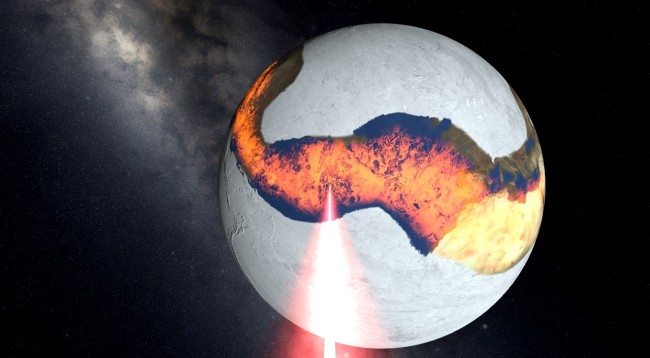
A laser melting a frozen Earth.
Planets in Universe Sandbox ² will be visually more detailed and responsive to interactions, all part of a project which we are internally calling “automata.”
This works by increasing the spatial resolution of data. That is, instead of having one point of data for an object’s property, like temperature, there will now be a 2D grid of data. In the example of temperature, this means that collisions can impact values locally, so heat spreads from the impact site rather than just raising the overall temperature. In turn, this will make for much more dynamic visuals. This will eventually also factor in elevation, making possible more detailed surface deformation and a lot more. And along with the improved composition system mentioned below, this will form the groundwork for basic life simulation.
Oh, and there will also be lasers.
Improved Composition System
Currently we support four materials for a body’s composition: iron, silicate, water, and hydrogen. We’ve been discussing ways we can include additional materials to this list. We’d also like to improve the interactions between radii and compositions, as the results are sometimes a bit confusing right now. Another component we’ve discussed is atmospheric composition. This is a very tricky problem with no clear solution, but it’s often requested and we are working toward it.
Space Megastructures
a.k.a. The Feature No One Knew They Wanted Until They Had It
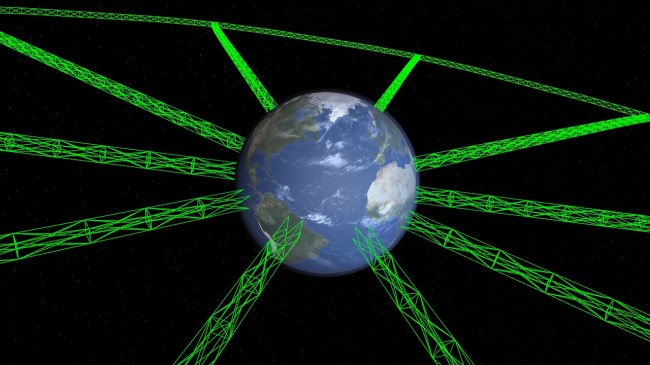
A megastructure around Earth. The green lines are the current, early rendering which will be improved.
We’re not ready to give away too many details on this yet… but doesn’t “Space Megastructures” sound pretty cool? The answer is yes, they do sound pretty cool, because they are. Using physics based space tethers as the idea behind the basic building block, these structures can come in many shapes and sizes. We still have a lot of work to do on these, but you can start imagining things along the lines of space elevators, Dyson spheres, and ring worlds.
Virtual Reality
What more needs to be said? Internally we have basic support for this going already, but there’s still a lot of work to do in fine-tuning the experience of reaching out, grabbing the Moon, then hurling it toward Earth. Our initial efforts are directed at getting it to work with the upcoming Steam VR based HTC Vive and the Oculus Rift.
User Interface Rewrite
This is largely an under-the-hood rewrite, but it’s going to make it possible to scale the interface for larger and different-sized resolutions, and also allow for language localization down the road. Technically, we’re transitioning from our own internal system to the new native system in Unity (our 3D engine) that didn’t exist when we started on this project 4 years ago.
Language Localization
As mentioned above, the rewrite to the user interface will make it a lot easier for us to implement localization. Our next step, once we’re ready, is to start the crowd-sourced localization process so we can get Universe Sandbox ² running in as many languages as possible.
Stellar Evolution Rewrite
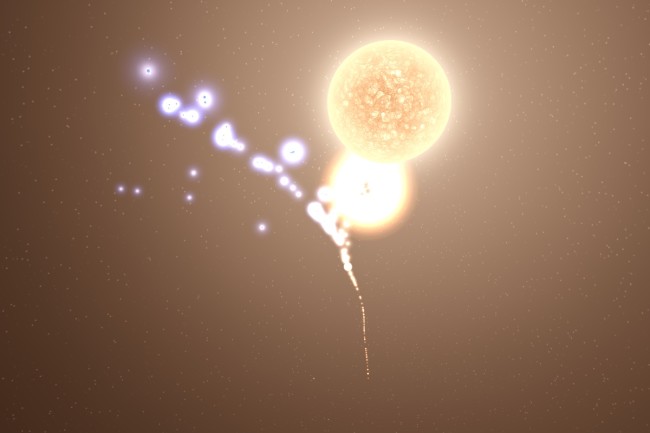
A Hertzsprung-Russell diagram in Universe Sandbox ² using the new stellar evolution model.
Universe Sandbox ² will support 16 evolutionary star types with the stellar evolution rewrite , versus the previous 5. The improved evolution model, based on these papers, is primarily a function of mass and age or metallicity, and will work for evolutionary types outside of main-sequence stars.
The result will be more dynamic and accurate properties for stars, as well as smoother transitions from type to type. The model also will now account for mass loss from solar winds, and be able to differentiate envelope from core. As a whole, this is also a stepping stone toward being able to illustrate stellar nucleosynthesis in Universe Sandbox ². We’ve hit a few snags in fully implementing this, but Jenn, our astrophysicist, has been making good, steady progress.
Total Body Fragmentation
This feature was partially implemented before, but was removed during the physics rewrite. Now we’re about ready to add it back in, and once we add some nice visual flair, this will make collisions and explosions even more epic and realistic as planets get completely broken apart.
Improved Galaxies
We’ve been saying for a bit now that we’d like to give galaxies some love again, as they’ve been mostly overlooked recently while we work on other projects. Our plan includes completely reworking procedural galaxies, which tend to all look the same right now, and fixing a number of bugs which currently make galaxies a little difficult to interact with.
Atmospheric Scattering
We often see requests from users that the view from the surface (press “C” when focused on a body) could be improved. We completely agree. One big step toward this is accounting for the atmosphere (if the planet has one), resulting in nice colored skies, sunrises, and sunsets, all products of atmospheric scattering. This will greatly increase the immersion when looking up from one of your planets.
Steam Workshop
Once we get the save/load mechanics even more solid, we plan to add in support for Steam Workshop. This will allow users to easily share saved simulations and objects with each other, which will be a very cool way of seeing what everyone is creating with Universe Sandbox ².
Achievements
Steam Achievements are another common request for Universe Sandbox ². They can add a little incentive for exploring the simulation and trying things you wouldn’t normally try. Have any good ideas for Achievements? Let us know on the forum!
Expanded Climate Change Exploration
Our climate models for Earth and Mars have been successfully implemented in Universe Sandbox ² for a while. But we’d like to strengthen our focus on this component to further help educate users on one of the most pressing issues we face today as citizens of the Earth.
Mobile Version
Again, another common request for Universe Sandbox ². We haven’t yet moved beyond discussing this as a possibility, but we are very interested in a mobile version. Universe Sandbox ² could work extremely well with touch commands, and a mobile version would greatly increase the amount of people who could get their hands on it. With constant improvements to mobile technology, and Unity’s tools for building mobile apps (the 3D engine we use), this could be a reality sooner than we think.
Fixing Bugs
We’ve hired a dedicated tester whose job is to rigorously test Universe Sandbox ², helping us find and fix bugs as we continue development. We’re a small team, and the nature of a massive space sandbox means that there are an extraordinary amount of things to test. Our community has been super helpful to this end, but we’re happy to now have someone who’s devoted to this task and can help fill in the cracks.
The Future of Universe Sandbox ²
This roadmap may seem ambitious (and it is), but we’ve already gone pretty far into unexplored territory. We’re committed to making Universe Sandbox ² better and better as we continue to create something that’s never been done before. We hope you’re as excited as we are about the future.
Get instant access to Universe Sandbox ² on Steam Early Access:
Alpha 18.2 | Planet Nine | Now Available
Jan 21st
Planet Nine
The discovery of a hypothetical ninth planet in our solar system was announced on January 20th, 2016 by researchers at the California Institute of Technology.
Universe Sandbox ² Alpha 18.2 features two simulations of Planet Nine. Run Steam to update, then check them out in Home -> Open -> Possible Planet Nine [and] Evidence of a Ninth Planet.
Or buy now for instant access to Universe Sandbox ² on Steam Early Access:
http://store.steampowered.com/app/230290/
The announcement comes after years of research into explaining the peculiar, but very similar, orbits of six small bodies orbiting beyond Neptune. Many theories have been proposed, but none has been as compelling as a very distant ninth planet pulling these bodies into their highly elliptical orbits. Using mathematical modeling, the two researchers, Konstantin Batygin and Mike Brown, have shown that a ninth planet fits very well into the data we have about objects in the Kuiper Belt and beyond.
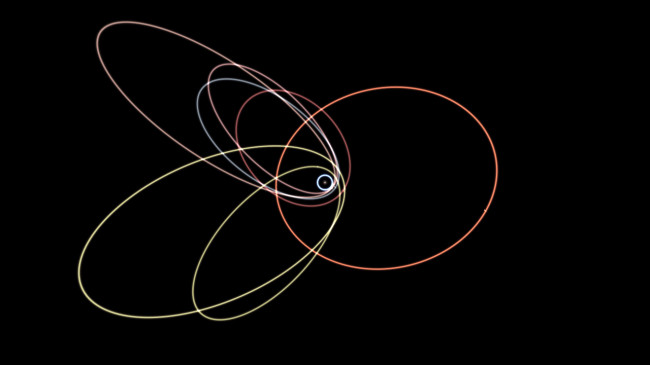
There’s only a 1 in 15,000 chance that the clustering of the orbits on the left is coincidental. Another explanation is the gravitational influence of a ninth planet, whose orbit is represented by the yellow line on the right. (from Universe Sandbox ²)
Planet Nine has not been directly observed yet by telescope, which is why it is hypothetical. But the researchers say there is a very good chance of spotting it in the next five years. It is suspected to be about 10 times the mass of Earth, similar in size to Neptune, with an orbit that’ll take it around the Sun every 10,000 – 20,000 years.
Of course, we don’t know how Planet Nine got there. Brown and Batygin propose that this planet was formed in the early days of the solar system, along with Jupiter, Saturn, Uranus, and Neptune. Then it could have been shot outward by one of the gas giants, and instead of leaving the solar system entirely, it may have been slowed down by gas in the Sun’s protoplanetary disk, enough to keep it in orbit.
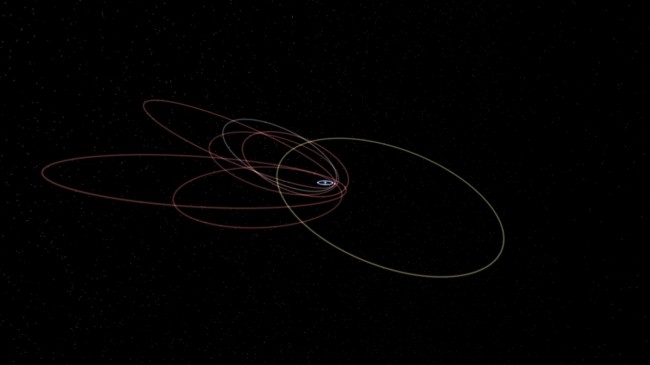
Alternative angle of Planet Nine (yellow orbital line) and the six objects used in the analysis. (from Universe Sandbox ²)
If the ninth planet does exist, then it will be the second time our solar system will have claim to nine planets… After, of course, Pluto was demoted in 2006. But Brown says there’s no question that the hypothetical ninth planet is indeed a planet. It’s likely much bigger than Earth, and has a large influence on other bodies in the solar system. And besides, Brown would know — his discovery of Eris was the reason Pluto was voted out.
Here’s a great discussion of Planet Nine by Mike Merrifield, an astronomer and professor at the University of Nottingham:
We’re hope you’re as excited about this possible discovery as we are! Make sure you check out the new simulations in Universe Sandbox ²: Home -> Open -> Possible Planet Nine [and] Evidence of a Ninth Planet.
See the complete list of What’s New in Alpha 18.2: What’s New
Additional links about Planet Nine:
Astronomers say a Neptune-sized planet lurks beyond Pluto
Evidence grows for giant planet on fringes of Solar System
Evidence for a Distant Giant Planet in the Solar System (research paper)
Alpha 18 | Much Faster Physics | Now Available
Dec 23rd
Native Physics Computation
Alpha 18 should show significantly better performance for Windows users, thanks to Thomas, our physics programmer, who has implemented something called Native computation. As explained in a previous blog post, Native mode essentially removes a layer from the physics computation, making the whole process much faster. It is enabled by default and effectively replaces the old Managed computation mode. Mac and Linux support for Native is coming in a future update.
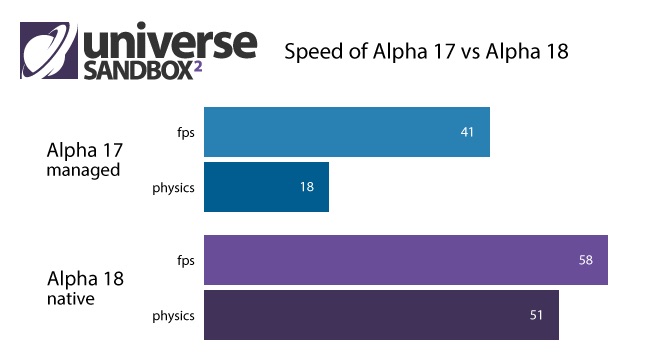
The graph above compares the new Native computation mode with the older, slower Managed mode. The data is from running the “Solar System | All Planets & All Moons” simulation on a 2012 MacBook Pro.
As you can see, the physics computation by itself is heads and tails faster when run in Native mode — about 2.8 times faster, in fact. This raw difference in physics calculation speed doesn’t typically translate one-to-one for FPS (frames per second) gain, but in this instance there was still an increase of 17 FPS. This is a substantial difference which you will see and feel when using Universe Sandbox ². This new computation mode is essentially the only big change in this update, but we think you’ll agree that it’s a big change.
To see how much faster it is, you can switch back to the old Managed mode in Home > Settings > General tab > Computation Device > ManagedCPU.
You can also display the frames drawn per second by enabling FPS Info in Home > Settings > Debug tab or press Alt + F.
Wolf 1061
We’ve also added a simulation of the Wolf 1061 system, which contains a recently discovered potentially Earth-like exoplanet. At 14 light-years away, Wolf 1061c is the closest potentially habitable planet ever discovered.
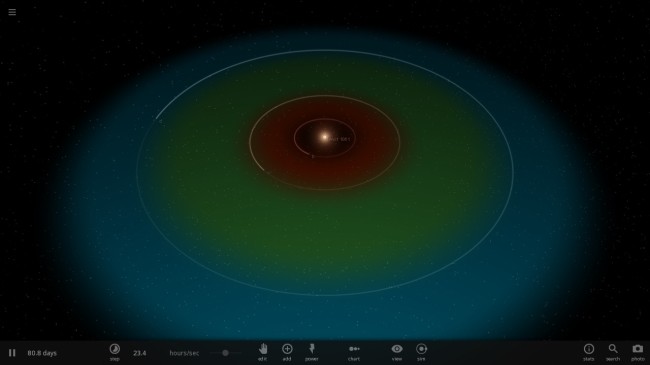
Maybe you’ve seen an image like the one above going around the internet. This is because the researchers who discovered Wolf 1061c used Universe Sandbox ² to create a visualization of the Wolf 1061 system. Very cool! You can check out their video on Youtube.
We’ve also been working hard on some other exciting projects and have made good progress. Read more about what we’ve got planned for upcoming updates: What Are We Working On? | Alpha 17 & Beyond.
Run Steam to update or buy Universe Sandbox ² now for instant access to Alpha 18 on Steam Early Access.
Check out the full list of new features, improvements, & bug fixes in What’s New.
And as always, let us know what you think about Alpha 18!
Universe Sandbox ² Alpha 17 Now Available
Nov 17th
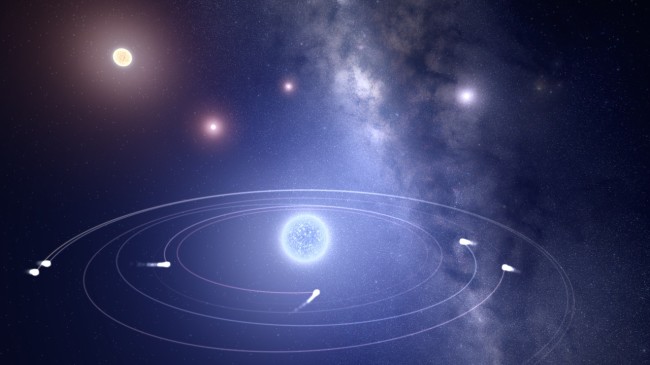
If you already own Universe Sandbox ², just run Steam to update to Alpha 17.
Or buy Universe Sandbox ² via our website or the Steam Store.
Alpha 17 | Star Glows & the Likelihood of Life
Alpha 17 introduces better looking star glows, a new Halley’s Comet simulation, and two values which show how similar a planet is to Earth and the speculative chance of it forming basic life. There’s also a “Make Pulsar” tool, better crash handling and reporting, and some bug fixes.
For a full list of what’s new in 17, please see our release notes.
You can read about some of the other features we are working on for future updates in our last post: What Are We Working On? | Alpha 17 & Beyond
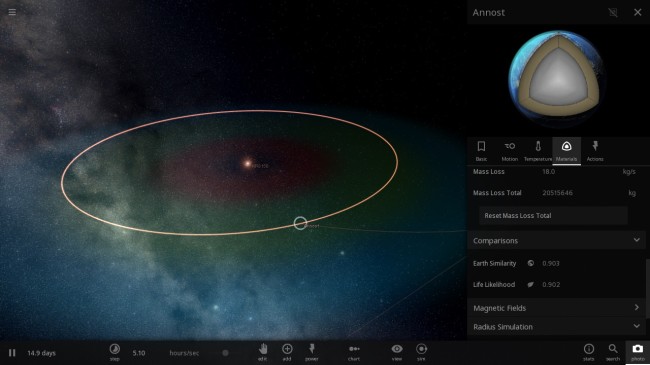
Let us know what you think of Universe Sandbox ² Alpha 17 using the in-game feedback or via…
Signup to be notified every time there’s a major update for Universe Sandbox ²
What Are We Working On? | Alpha 17 & Beyond
Oct 26th
Our past few updates have been relatively minor releases. They’ve focused on fixing bugs and stability issues, and aside from a few minor features, haven’t introduced anything new. Fixing these issues is extremely important, but for those users who hadn’t experienced any problems, these updates weren’t the most exciting.
But now we’re getting back up to speed after some good time off post-Steam release. Alpha 17 will be the first major release since Alpha 16 at the end of August, and we’re excited to begin showing off some of the bigger projects we’ve been working on.
At this time we can’t say for sure which features will make it into Alpha 17. Some will be implemented only in their early stages, and others will likely have to wait until later updates. These disclaimers aside, here are a few of the things which you can look forward to in Alpha 17 and beyond:
1. Rewritten Stellar Evolution & Classification
Previously there were 5 star types in Universe Sandbox ². Now, with the rewrite, there will be 16. The improved stellar evolution model is now primarily a function of metallicity, and will work for types outside of main-sequence stars.
The result will be more dynamic and accurate properties for stars, as well as smoother transitions from type to type. The model also will now account for mass loss from solar winds. It may take a bit of time to fully incorporate all of the changes, but now that Jenn has added in these new, robust evolution models, many new possibilities await.
2. More Planetary Details
Random planets in Universe Sandbox ² are going to be visually more detailed and responsive to interactions, all part a project which we are internally calling “automata.”
In the beginning, this will work alongside our climate component to increase the spatial resolution. That is, instead of having one point of data for an object’s property, like temperature, there will now be a 2D grid of data. In the example of temperature, this means that collisions can impact values locally, so heat spreads from the impact site rather than just raising the overall temperature. In turn, this will make for much more dynamic visuals.
This higher resolution of data will also apply to elevation, influencing water levels, pressure, and material states. Further down the line this could open up doors for better surface deformation and shaping, and even set up the groundwork for basic life evolution. It’s a very exciting project, but also highly experimental: it’ll be a work-in-progress for some time to come, even when it first shows up in an update, and we can’t say for sure what it’ll eventually be able to do.
3. Better Star Glows & Rendering
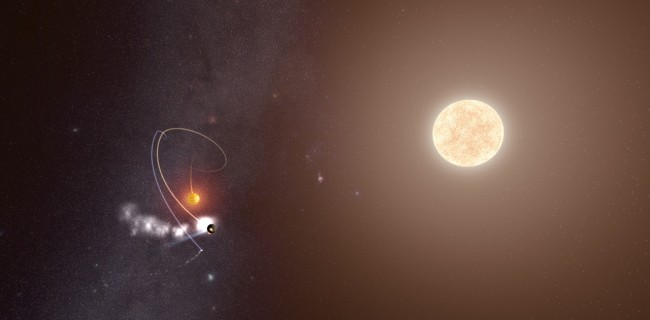
This one mostly speaks for itself. Star glows and rendering are going to look a whole lot better, with smoother fading and fewer clipping issues. Georg hopes to eventually add a little coronal animation, too.
4. Back-End Changes to the User Interface
Chris is busy porting over the current custom user interface to use Unity’s user interface system. At first this may fall into the category of “Not Too Exciting For Most Users,” as it won’t involve any design changes, but this rewrite of the user interface is going to make possible a handful of things for Universe Sandbox ² further down the line. Essentially, it’s future-proofing.
The biggest advantage of this is the support for multiple character sets and a scalable interface. This translates into support for languages using non-Roman characters, and an interface that works on non-standard resolutions, such as 4k or mobile. And while a mobile version of Universe Sandbox ² is not coming any time soon, should we eventually decide to take that path, this change will make it all the more feasible. Feel free to also use this as evidence that we are not planning on wrapping up development in the near future.
5. Native Physics Code
Alpha 15 introduced Thomas’s rewrite of the physics component in Universe Sandbox ², which made everything run a whole lot faster. That was only the first part. This second part is implemented as native code, versus the previously implemented managed code. Without getting too technical, this essentially removes a step from the process, making it run a bit faster. There will be more performance improvements to come after native implementation, but this one is a big step.
After all of this is firmly in place, then it’s time for VR… But that’s a blog post for another day.
Sign up to be notified whenever there’s a major update: Universe Sandbox ² Email List

